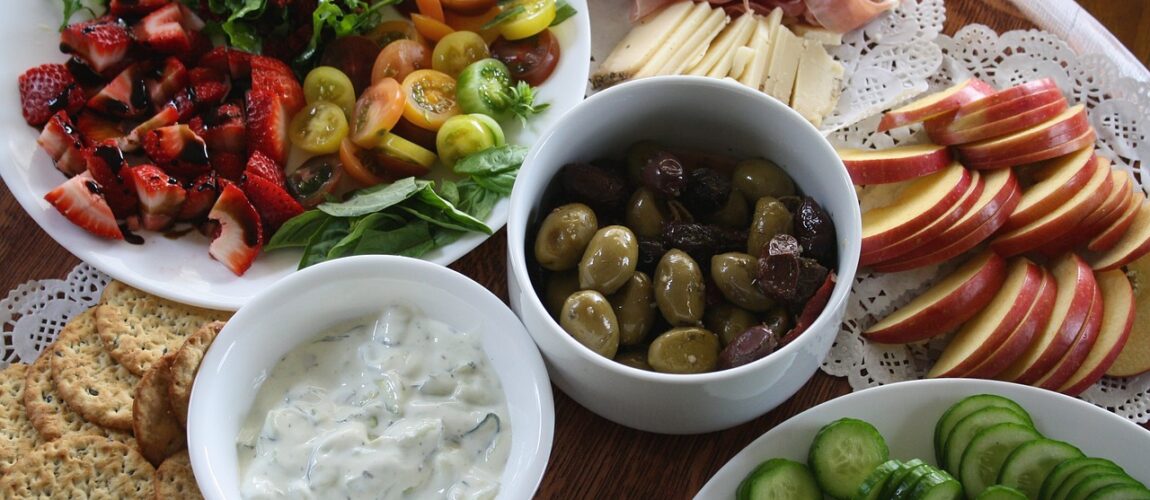
Eating healthy is essential for everyone, whether you’re a child, adult, man, or woman. This guide will help you understand what healthy food is, why it’s good for you, and how to incorporate it into your daily life.
What is a Balanced Diet?
A balanced diet means eating the right amounts of different types of foods so your body gets all the nutrients it needs. Think of it like building a balanced tower with different colored blocks. Each color represents a different food group: fruits, vegetables, grains, proteins, and dairy.
Fruits and Vegetables: Nature’s Candy
Eating a variety of fruits and vegetables is like getting a rainbow of vitamins and minerals. Try to eat different colors every day! For example:
- Breakfast: A smoothie with spinach (green), banana (yellow), and berries (blue and red).
- Lunch: A salad with mixed greens, cherry tomatoes, carrots, and cucumbers.
- Dinner: Stir-fried vegetables like bell peppers (red, yellow, green) with broccoli and carrots.
Fruits and vegetables help keep you strong and healthy by providing essential vitamins and minerals.
Whole Grains: The Energy Boosters
Whole grains, like whole wheat bread, brown rice, quinoa, and oats, give you energy to go about your day. They contain fiber, which helps your tummy feel good and keeps you full longer.
- Breakfast: Oatmeal topped with fresh fruits and nuts.
- Lunch: A sandwich made with whole wheat bread, filled with lean protein and veggies.
- Dinner: Brown rice or quinoa as a side dish with your favorite protein and vegetables.
Lean Proteins: The Muscle Builders
Proteins, like chicken, fish, beans, tofu, and nuts, help build and repair your muscles. They are essential for growth and maintenance of body tissues.
- Breakfast: Scrambled eggs with a side of avocado.
- Lunch: A grilled chicken salad with mixed greens and a light vinaigrette.
- Dinner: Baked salmon with a side of steamed broccoli and quinoa.
Healthy Fats: The Brain Boosters
Not all fats are bad! Healthy fats, found in foods like avocados, nuts, seeds, and olive oil, help your brain work better and keep your skin and hair healthy.
- Breakfast: Avocado toast on whole grain bread.
- Lunch: A mixed nuts snack.
- Dinner: A salad dressed with olive oil and topped with seeds.
Why Should You Avoid Too Much Sugar and Junk Food?
Eating too many sugary and junk foods, like candy, soda, and chips, can be bad for you. These foods can make you feel tired, cause weight gain, and lead to health problems like diabetes.
- Healthy Alternatives: Instead of soda, drink sparkling water with a splash of lemon. Swap candy for a handful of berries or an apple with peanut butter.
Hydration: The Magic of Water
Drinking plenty of water is super important. Water helps your body stay cool, keeps your skin clear, and helps you stay focused. Aim to drink about 8 glasses of water a day.
- Tip: Carry a water bottle with you and take sips throughout the day.
Smart Snacking
Healthy snacks keep you energized between meals. Choose snacks that are nutritious and filling.
- Healthy Snacks: Apple slices with almond butter, carrot sticks with hummus, or a yogurt parfait with fresh berries.
Meal Planning: Making Healthy Choices
Planning your meals helps you eat a balanced diet. You can prepare meals in advance to ensure you have healthy options ready.
- Tip: Make a weekly menu and grocery list. Prep ingredients like chopping vegetables or cooking grains ahead of time.
Seasonal and Local Foods
Eating fruits and vegetables that are in season and grown locally is good for you and the planet. Seasonal foods are fresher, taste better, and have more nutrients.
- Example: In the summer, enjoy fresh berries and tomatoes. In the winter, try root vegetables like carrots and sweet potatoes.
Plant-Based Meals: Trying New Things
Plant-based meals are meals that don’t have meat. You can try eating more beans, lentils, and tofu. They are yummy and good for your body and the environment.
- Meal Idea: A lentil soup with lots of vegetables or a tofu stir-fry with mixed veggies.
Probiotics: Friendly Bacteria
Probiotics are good bacteria found in foods like yogurt, kefir, and fermented foods like sauerkraut and kimchi. They help your stomach stay healthy and can improve your digestion.
- Breakfast: Yogurt with honey and fresh fruit.
- Snack: A glass of kefir.
Reduce Sodium
Too much salt can be bad for your heart. Try to eat less salty snacks and choose fresh foods instead.
- Tip: Use herbs and spices to flavor your food instead of salt.
Reading Nutrition Labels
Nutrition labels tell you what’s inside the food you eat. Look for foods that are low in sugar and high in vitamins and minerals.
- Tip: Check the serving size and compare the number of calories, fat, sugar, and sodium to make healthier choices.
Dining Out: Making Healthy Choices
When you eat out, try to choose healthier options like salads, grilled chicken, or veggie dishes. Avoid fried foods and sugary drinks.
- Example: Order a grilled chicken sandwich with a side salad instead of fries.
Reducing Added Sugars
Too much added sugar can make you feel tired and unhealthy. Choose natural sugars found in fruits instead.
- Tip: Use fresh fruits to sweeten your yogurt or oatmeal instead of sugar.
Antioxidants: The Protectors
Antioxidants are found in fruits and vegetables and protect your body from getting sick. Blueberries, strawberries, and spinach are full of antioxidants.
- Smoothie Idea: Blend spinach, blueberries, banana, and almond milk for a delicious antioxidant-rich smoothie.
Organic Foods
Organic foods are grown without harmful chemicals. They are better for the environment and might be healthier for you.
- Tip: Look for organic labels on fruits, vegetables, dairy, and meats.
Omega-3 Fatty Acids
These are healthy fats found in fish, walnuts, and flaxseeds. They are good for your brain and heart.
- Meal Idea: Grilled salmon with a side of quinoa and steamed vegetables.
The Importance of Breakfast
Breakfast gives you energy to start your day. Choose healthy options like oatmeal, eggs, or fruit.
- Breakfast Idea: Oatmeal topped with banana slices and a sprinkle of chia seeds.
Green Tea
Green tea is a healthy drink full of antioxidants. It can help keep your body healthy.
- Tip: Swap your sugary drinks for a cup of green tea.
Portion Control
Eating the right amount of food is important. Too much can make you feel tired, and too little won’t give you enough energy.
- Tip: Use smaller plates to help control portion sizes.
Whole Foods
Whole foods are foods that are not processed. They are natural and full of nutrients.
- Example: Fresh fruits, vegetables, whole grains, and lean proteins are all whole foods.
Reducing Red Meat
Eating less red meat, like beef, can be good for your heart. Try eating more chicken, fish, or plant-based proteins.
- Meal Idea: A veggie burger made from black beans and quinoa.
Cooking at Home
Cooking at home is healthier because you know what’s in your food. Plus, it’s fun to cook with your family!
- Tip: Try new recipes and experiment with different ingredients.
Mediterranean Diet
The Mediterranean diet includes lots of fruits, vegetables, whole grains, and healthy fats. It’s a tasty and healthy way to eat.
- Meal Idea: A Greek salad with tomatoes, cucumbers, olives, feta cheese, and a drizzle of olive oil.
Healthy Eating Summary
Eating healthy means choosing a variety of foods that give you the nutrients your body needs. Remember to eat fruits, vegetables, whole grains, proteins, and healthy fats. Drink plenty of water and avoid too much sugar and junk food. Plan your meals, try new foods, and enjoy cooking at home with your family.
By following these simple tips, you’ll be on your way to feeling great and staying healthy!
Also Read:
19 Superfoods for Excellent Gut Health: Benefits, Recipes, and Cooking Methods
How Women Can Lead a Healthy Life and Maintain Balance in Physical and Mental Health.
At AddtoYou.org, our content is crafted by a dedicated team of health enthusiasts, nutrition experts, fitness trainers, and mental health professionals. Together, we bring a wealth of knowledge and experience to help women lead healthier, more balanced lives. Our team is passionate about sharing practical tips and insights on physical well-being, mental health, and nutritious eating. We are committed to providing evidence-based advice and inspiring you to achieve harmony in mind, body, and soul. Join us on this journey to wellness and discover how you can add more health and happiness to your life.

[…] A Simple Guide to Healthy Eating for All Ages. […]
[…] A Simple Guide to Healthy Eating for All Ages. […]